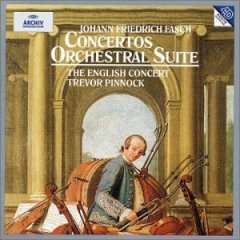Fasch - Concertos, Orchestral Suite (1996)
Fasch - Concertos, Orchestral Suite (1996)

1. Fasch, Johann Friedrich - -- Concerto a 8 in D-Dur - 1. Allegro (02:15) Concerto a 8 in D major FWV L: D1 2. Fasch, Johann Friedrich - 2. Largo (01:27) 3. Fasch, Johann Friedrich - 3. Allegro (03:02) 4. Fasch, Johann Friedrich - -- Concerto in c-moll - 1. Allegro (03:35) Concerto in C minor FWV L: c2 5. Fasch, Johann Friedrich - 2. Largo (03:18) 6. Fasch, Johann Friedrich - 3. Allegro (02:23) 7. Fasch, Johann Friedrich - -- Suite in g-moll - 1. ohne Satzbezeichnung (06:16) Overture (Suite) in G minor FWV K: g2 8. Fasch, Johann Friedrich - 2. Aria - Largo (03:58) 9. Fasch, Johann Friedrich - 3. Jardiniers (01:50) 10. Fasch, Johann Friedrich - 4. Aria - Largo (02:16) 11. Fasch, Johann Friedrich - 5. Aria - Allegro (03:53) 12. Fasch, Johann Friedrich - 6. Gavotte (02:26) 13. Fasch, Johann Friedrich - 7. Menuet (02:38) 14. Fasch, Johann Friedrich - -- Concerto in B-Dur - 1. Largo - 2. Un poco allegro (06:17) Concerto in B flat major FWV L: B1 15. Fasch, Johann Friedrich - 3. Largo (01:57) 16. Fasch, Johann Friedrich - 4. Allegro (03:15) 17. Fasch, Johann Friedrich - -- Concerto in D-Dur - 1. Allegro (03:10) Concerto in D major FWV L:D14 18. Fasch, Johann Friedrich - 2. Largo (02:29) 19. Fasch, Johann Friedrich - 3. Allegro (03:00) The English Concert Trevor Pinnock – conductor
While still a law student at the University of Leipzig, Johann Friedrich Fasch (1688–1758) composed an orchestral suite and passed it off as one of Telemann’s at a concert by the Collegium Musicum. Fasch was taken by surprise when his fellow students expressed their enjoyment of the work and not one of them suspected anything, or if they did, nothing was ever said. If Fasch ever had any doubt about embarking on a musical career, this incident must have proven that he possessed the necessary talent by imitating the leading composer of the day and going unnoticed in doing so!
Fasch came from a family of churchmen and, following the death of his father, he began a series of moves that would finally place him in Leipzig as one of the first pupils of Johann Kuhnau, cantor at the renowned Thomasschule. After graduating from the University of Leipzig, Fasch hit the road, traveling throughout Germany, and studying with Christoph Graupner in Darmstadt. Eventually Graupner wound up in Prague where he became an employee of Count Wenzel Morzin, the dedicatee of Vivaldi’s op. 8 set of concertos, which included the well-known quartet of works known collectively as The Four Seasons . In 1722, Fasch was offered and accepted the post of Kapellmeister at the court of Zerbst. With the exceptions of a trip to Prague in 1725, an extended stay in Dresden, and several trips to Köthen, Fasch remained in Zerbst for the rest of his life.
It’s relatively easy for us to categorize the music of Bach, Handel, Telemann, and many of their lesser-known contemporaries, but pigeonholing Fasch’s music isn’t as easy. A 1743 inventory of the Zerbst library shows that Fasch had assembled the latest works of the best-known Italian masters—including Vivaldi and Albinoni—as well as music of Graun and Handel. This shows how interested Fasch was in keeping up with the latest stylistic trends. He was essentially a Baroque composer, indebted to the Italian style with the occasional side trip to the French orchestral suite, but Fasch also wasn’t beyond experimenting and employing ideas that elsewhere would morph into a more gallant or Classical idiom. Characteristic of Fasch’s music are the emancipation of wind instruments, an interest in syncopation, and a more chromatic syntax. Fasch also wrote in a texturally simpler style, replacing the complexity of independent lines with a melody and bass with accompanying figures.
The Lullian orchestral suite included here is typical of the genre with the obligatory overture being followed by a series of short dance-like movements including a gavotte, minuet, two arie, and a descriptive movement called Jardiniers . Three of the four concertos on this release are patterned after three-movement Venetian models, while the fourth—that for chalumeau, an ancestor of the clarinet—is based on the Corellian concerto da chiesa.
These spirited and genial performances are textbook from first note to last, wedding top-notch soloists to one of the finest period-instrument orchestras around with stunning results that were captured in a rich aural environment. The result is a set of performances that yields nothing to the competition.--- Michael Carter, arkivmusic.com
download: uploaded anonfiles yandex 4shared solidfiles mediafire mega filecloudio
Zmieniony (Sobota, 09 Listopad 2013 14:53)








